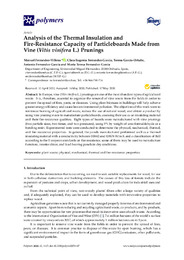Por favor, use este identificador para citar o enlazar este ítem:
https://hdl.handle.net/11000/34605Registro completo de metadatos
| Campo DC | Valor | Lengua/Idioma |
|---|---|---|
| dc.contributor.author | Ferrández-Villena, Manuel | - |
| dc.contributor.author | FERRÁNDEZ, MARÍA TERESA | - |
| dc.contributor.author | Ferrandez-Garcia, Clara Eugenia | - |
| dc.contributor.author | Ferrández García, Antonio | - |
| dc.contributor.author | Garcia-Ortuño, Teresa | - |
| dc.contributor.other | Departamentos de la UMH::Ingeniería | es_ES |
| dc.date.accessioned | 2025-01-16T17:56:25Z | - |
| dc.date.available | 2025-01-16T17:56:25Z | - |
| dc.date.created | 2020 | - |
| dc.identifier.citation | Polymers | es_ES |
| dc.identifier.issn | 2073-4360 | - |
| dc.identifier.uri | https://hdl.handle.net/11000/34605 | - |
| dc.description.abstract | In Europe, vine (Vitis vinifera L.) prunings are one of the most abundant types of agricultural waste. It is, therefore, essential to organize the removal of vine waste from the fields in order to prevent the spread of fires, pests, or diseases. Using plant biomass in buildings will help achieve greater energy e ciency and cause less environmental pollution. The objectives of this work were to minimize burning of agricultural waste, reduce the use of natural wood, and obtain a product by using vine pruning waste to manufacture particleboards, assessing their use as an insulating material and their fire-resistance qualities. Eight types of boards were manufactured with vine prunings (two particle sizes, two times, and two pressures), using 9% by weight of urea-formaldehyde as a bonding resin. Experimental tests were conducted to determine the physical, mechanical, thermal, and fire-resistance properties. In general, the panels manufactured performed well as a thermal insulating material with a conductivity between 0.0642 and 0.0676 W/m K and a classification of Bd0 according to the European standards on fire resistance; some of them may be used to manufacture furniture, interior décor, and load-bearing panels in dry conditions. | es_ES |
| dc.format | application/pdf | es_ES |
| dc.format.extent | 11 | es_ES |
| dc.language.iso | eng | es_ES |
| dc.publisher | MDPI | es_ES |
| dc.relation.ispartofseries | 12 | es_ES |
| dc.relation.ispartofseries | 5 | es_ES |
| dc.rights | info:eu-repo/semantics/openAccess | es_ES |
| dc.rights | Attribution-NonCommercial-NoDerivatives 4.0 Internacional | * |
| dc.rights.uri | http://creativecommons.org/licenses/by-nc-nd/4.0/ | * |
| dc.subject | plant waste | es_ES |
| dc.subject | physical | es_ES |
| dc.subject | mechanical | es_ES |
| dc.subject | thermal and fire-resistance properties | es_ES |
| dc.subject.other | CDU::6 - Ciencias aplicadas::62 - Ingeniería. Tecnología | es_ES |
| dc.title | Analysis of the Thermal Insulation and Fire-Resistance Capacity of Particleboards Made from Vine (Vitis vinifera L.) Prunings | es_ES |
| dc.type | info:eu-repo/semantics/article | es_ES |
| dc.relation.publisherversion | https://doi.org/10.3390/polym12051147 | es_ES |

Ver/Abrir:
2020.- Polymers. Analysis of the Thermal.pdf
733,93 kB
Adobe PDF
Compartir:
 La licencia se describe como: Atribución-NonComercial-NoDerivada 4.0 Internacional.
La licencia se describe como: Atribución-NonComercial-NoDerivada 4.0 Internacional.
.png)